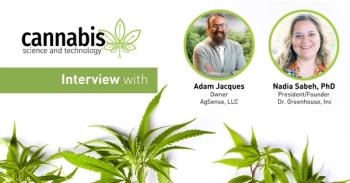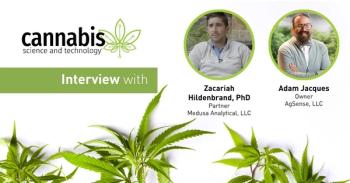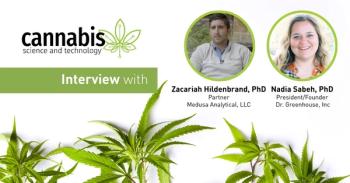
Cannabis Science and Technology
- July/August 2019
- Volume 2
- Issue 4
The Keys to Clean Cannabis

Here we identify the main sources of disease that could impact grow operations and best practices for clean cannabis.
If you are a grower, you know that your main goal must be maintaining a cultivation facility that is free of plant pathogens. Plant diseases can bring down your grow and leave you with a troublesome mess that must be cleaned out and months of lost profits. Recovery from a major disease outbreak is costly in terms of impact on yield and labor costs, not to mention the potential negative impact on your reputation as a grower. Of course, a small level of disease can be tolerated and treated, but you cannot let it get out of hand! In this month’s “Cultivation Classroom,” we identify the main sources of disease that could impact your grow operations.
Every cultivator has their horror stories about plant pathogens and the havoc they wreak. I am talking about those microbial menaces that you can’t even see until it is pretty much too late to have effective eradication without harm to your profits. Whether admitted or not, every cultivation facility has plant pathogens: outdoor, indoor, and greenhouse. However, my focus in this “Cultivation Classroom” is on greenhouse and warehouse cultivation facilities-the expensive controlled environment agriculture (CEA) facilities-we need to prevent the entrance of these harmful microbial pathogens into these special facilities. Growers raise and invest serious money to build these facilities and often give up significant equity to ensure the highest quality in the finished facilities. That investment needs to be protected.
Prevention
When creating a clean grow facility, the key is prevention. The key to prevention is to start clean. But where does that level of clean start? My ideal cultivation facility would be a cleanroom, similar to those you find at the National Aeronautics and Space Administration (NASA) to ensure that we don’t contaminate Mars and the other planets in our solar system. It sounds pretty wild, but I started out obsessing about microbial contamination in 1995 while I worked for NASA. I was technical group leader of NASA’s Jet Propulsion Laboratory’s (JPL) Planetary Protection Group. Our job was to build the Pathfinder Lander as free of microbiological contamination as humanly possible. We were able to maintain an environment virtually free of microbes. This was accomplished by designing into our facility a number of barriers to maintain a clean spacecraft assembly environment (see Figure 1). (See upper right for Figure 1, click to enlarge.) We cannot achieve the same level of cleanliness in a cultivation facility, nor do we want to because the costs are prohibitive, but the same general approach applies.
When we create the optimal growth environment for plants in our high-tech CEA cultivation facilities, we create an excellent growing environment for microbes, both beneficial microbes and harmful pathogenic microbes. We start out with good intentions in preparing the growing environment for plants, but in the process, inadvertently, create a perfect environment to foster the growth of microbes, both good and bad.
As a result, you must start with a clean and disinfected facility. Make sure your cleaning crew and staff members wear appropriate protective clothing to prevent microbes, viruses, dust, pollen, and atmospheric detritus on skin and clothing from contacting plants or other surfaces. Make your motto: “Start clean and stay clean!” Before you introduce any new clones, plants, people, or processes into the facility clean every surface with a state-approved environmentally-friendly disinfectant agent, such as a hydrogen peroxide (H2O2) based solution. The top three “must have” rules to assist with keeping your facility clean are:
- Every employee must change into appropriate clean, protective gear before entering the facility. This includes footwear, protective “bunny suit” coveralls, gloves, and beard and hair coverings at a minimum.
- No visitors are allowed into the facility.
- No decorative plants are allowed into the facility.
A Good CEA Cultivation Facility
In addition to using proven cleaning and sterilization techniques, a good CEA cultivation facility is tightly sealed and properly screened to keep insect pests out; this is an essential step in disease control, as insects are vectors for both bacteria and viruses. In addition, a grower needs a state-of-the-art heating, ventilation, and air conditioning (HVAC) system to filter the air to remove additional pathogen vectors on airborne dust, pollen, and microscopic arthropods. While you must maintain a constant temperature and humidity environment to foster a perfect environment for optimal health and yield of plants, these are the same conditions that allow microbial life to thrive and expand across the grow facility. When high-tech filtered air-handling systems are used, disease vectors can be reduced, but not eliminated. When an appropriate HVAC system is implemented, structural sealing issues addressed, and proper screening placement are built into the design, combined with cleanliness, most issues related with prevention of disease will be addressed. In summary, these preventative measures include:
- Sterilize and disinfect every surface you can reach
- Institutionalize the motto, “start clean and stay clean” through strict procedures for employees
- Create barriers, such as ante rooms and screens, that prevent the entry of microbes as a means of preventing microbial disease propagation
- Construct a facility that is tightly sealed and ideally is maintained under a slightly positive pressure so that the airflow is always outward. This prevents insects, which can carry viruses, and airborne microbes from entering the facility.
- Screen and filter the air that enters the facility at the intake to prevent insects and microbes from entering the facility
- Install a state-of-the-art HVAC system to further filter the air within the facility and maintain the clean air
- Implement a regular cleaning regimen throughout the facility and equipment with state-approved environmentally-friendly disinfectant agents such as hydrogen peroxide based solutions
- Train the cultivation team in proper industrial hygiene, such as never wearing street clothes or shoes
- Always wear fresh nitrile gloves and beard and hair protective covering
- Always use clean and sterilized tools. Clean and sterilize after every cutting.
Plant Tissue Culture
I always recommended these preventative measures to prevent the introduction of plant pathogens into cultivation facilities, and will continue to do so, but cultivators face a problem that is insidious and has caused innumerable losses: contaminated clones and teens. No matter how stringent your standard operating procedures are, one contaminated clone can cause a devastating infection and loss across your entire growing operation. You’ve heard the proverb that one bad apple can ruin the whole barrel. Well, one bad clone can ruin your entire grow.
However, there is a solution and it is becoming more and more mainstream in our industry. As our industry continues to mature it will take on more of the practices of modern mainstream horticulture. One such practice is the widespread use of tissue culture to supply disease-free clones and teens for cultivators. Nurseries whose stock originates from tissue culture facilities to avoid contamination should become the mainstay of our industry. This is in contrast to the current situation where most purchased clones from nurseries are generated from mature “mother” plants. This is particularly important for cannabis because so many of the strains are contaminated with fungi, bacteria, and viruses. Tissue culture is the technology that can enable the much needed production of disease-free clones.
Does this mean a cultivator can trust clones originating from a tissue culture facility? As a consumer you should ask if the facility and the batch of clones have been tested in-house for common diseases like the ones shown in Table I. (See upper right for Table I, click to enlarge.) If you are a larger grower, your incoming plants should be monitored by a trusted third-party plant pathogen laboratory. In my experience, these conventional agriculture laboratories don’t advertise this service, but some are set up to handle such a request.
If you wish to safeguard your facility and crop, I suggest you test for two microbes before the clones come out of quarantine: fusarium and pythium. These are the two most prevalent infections brought into cultivation facilities. In my experience, they are the most commonly reported contaminants from nursery plants.
Pythium is a genus of a fungus-like microorganism belonging to the class Oomycota. It is distinctive because of its water-borne swimming and is responsible for its rapid transmission in a recirculating hydroponic facility. It is responsible for a type of root rot that results in the browning of the roots and the disruption of water and nutrient uptake resulting in wilt. It can have an almost immediate impact resulting in “damping off” that results in the death of young plants and seedlings. The impact on established plants results in stunted growth, chlorosis, which would certainly affect yield.
Fusarium is a member of the kingdom Fungi; it can propagate by water born spores. Like pythium, it causes root rot and subsequent wilt. The wilt is distinctive in that as the leaves become yellowish and then brown, the tips curl up. This is in contrast to the yellow-brown leaves droop down when the plant is infected with pythium.
Professor Zamir Punja, a plant scientist from Simon Fraser University in British Columbia, recently published two studies on pathogens that included these microbes (1,2). I recommend reading those studies for a deep dive into the subject.
Expert Point of View
To learn more about this topic, we spoke with Dr. Hope Jones, a plant tissue culture specialist.
What is your background and experience in agriculture and in the cannabis sector specifically?
Dr. Hope Jones: I have a diverse background in this industry. I’m a grower first and foremost. I just happen to believe science makes me a better grower.
I have worked as the Chief Scientific Officer for a large cannabis cultivation and product manufacturer in Arizona. I am also the scientific research advisor for Arizona-NORML (National Organization for the Reform of Marijuana Laws), which has been a part of many matters of local importance to cannabis policy and reform including drafting legislation in Arizona to implement the recently passed hemp and testing bills.
You mentioned your expertise in tissue culture. Let’s start there, do you use or see a need for plant pathogen testing in your customers operations?
Jones: While it’s true that the time and space required to commercialize production of disease-free plants is reduced, those of us operating these businesses must ensure we are in fact producing disease-free plants.
Non-cannabis tissue culture-based industries start with healthy stock material (also known as moms). We typically are not starting with healthy material. These other industries have university and third-party laboratory services available, while our industry has had very limited services available. While there is a growing number of cannabis testing laboratories that will test cannabis, cannabinoid profiles, and so on, these laboratories do not necessarily test for specific diseases of strains.
It matters if the clones we sell are disease-free because both the genetic makeup and the health of the plant can affect its susceptibility to pest problems as well as yield.
What should growers expect from a third-party testing laboratory in this regard?
Jones: Most agriculture laboratories have tremendous knowledge and have been working with growers for a long time. Make an appointment, get to know them. Discuss your situation and ask for their help in establishing policies and procedures. If they offer these services, it’s worth every dollar, as the extra cost will be balanced against the potential risks.
I have been working with a local company here in Arizona for testing plants in tissue culture for plant diseases. Normally, laboratories require quite a bit of plant material to analyze, but I met with this laboratory prior and discussed my situation. I said, “I have very small plants in vessels; what’s the best way to test?” We developed a testing method that worked for both of us. Taking this time is good business for me and them.
Should this be regulated or can we police ourselves?
Jones: Yes and yes.
There should be regulation to ensure public health and to stop poor cultivation practices that encourage disease and the spread of plant viruses. There is no need, however, to adopt unreasonable regulations that are not based on relevant data or attempt to out regulate all other industries.
We are a nascent industry with aggressive growth. So, until studies are conducted that better describe the ideal regulations, I’m of the mind that we start with practices used in other industries-as long as these regulations are directly testing for microorganisms that are known to be of public-health concern and actually found on cannabis.
Also, as a grower, I don’t want to hope I pass all microbial testing or hope my plants are disease free. I want to know. And the easiest, but most overlooked, way to do that is to quarantine all incoming material.
There are ways we growers can know we will pass all microbial testing before sending to the laboratory-by implementing in-house practices that ensure we are clean growers. We can conduct microbiological analysis of the air, purchase a water activity meter, and conduct in house aerobic plate counts.
Conclusion
As we move into an era of higher regulation and consumer expectations, we need to ensure that our crops are clean and disease-free. Starting with strong and verifiable practices of cleanliness and prevention of disease, followed by incorporating the latest developments in tissue culture, we can ensure clean and disease-free results-and improve our profitability. It may take effort to “start clean and stay clean,” but that effort will pay off as consumers become fans and the demand for your product skyrockets-just like the missions to Mars.
References:
- Z.K. Punja and G. Rodriguez, Can. J. Plant Pathol.40(4), 498–513 (2018).
- Z.K. Punja, Can. J. Plant Pathol. 40(4), 514–527 (2018).
About the Interviewee
Dr. Hope Jones is Chief Scientific Officer of Emergent Cannabis Sciences-a research, development and advising company-whose mission is to drive scientific innovation within the cannabis industry. Dr. Jones was formally Chief Scientific Officer for C4 Laboratories, a research, advanced analysis, and characterization of cannabis medicine company. She is a graduate of the University of Arizona’s Controlled Environment Agriculture Center (CEAC) where she worked to propagate endangered native species using tissue culture techniques. She is one of a very select few scientists in this country that have extensive experience in utilizing these techniques with cannabis specifically.
About the Columnist
Dr. Roger Kern is a scientist and technologist who cares deeply about the cultivation and health of plants in the cannabis industry. With his PhD in microbiology from the University of California, Davis, Plant Growth Laboratory, he solves the most challenging problems in hydroponics, from studying the root microbiome to developing nutrients and lighting systems to ensure plant health and a disease-free lifecycle. He spent 22 years at NASA’s Jet Propulsion Laboratory as a scientist, technologist, and research leader before becoming the President of Agate Biosciences, a consulting firm for project management, systems engineering, and science in CEA for the past eight years. He leads developments to optimize sustainability, consistency, quality, and yield without compromising plant health. Direct correspondence to:
How to Cite This Article
R. Kern, Cannabis Science and Technology2(4), 16–29 (2019).
Articles in this issue
about 6 years ago
Solubilization of Phytocannabinoids Using Cyclodextrinsabout 6 years ago
Microbiological Attributes of Cannabis-Derived Productsabout 6 years ago
The What, How, and Why of Water Activity in Cannabisabout 6 years ago
Cannabis Is Medicine . . . Test It like MedicineNewsletter
Unlock the latest breakthroughs in cannabis science—subscribe now to get expert insights, research, and industry updates delivered to your inbox.





